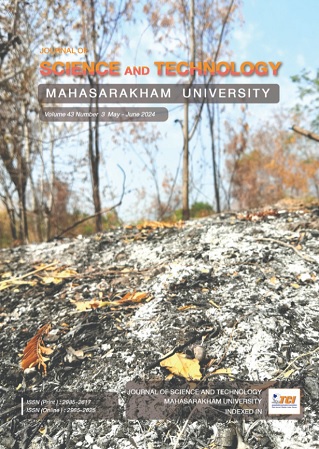การทบทวนวรรณกรรมอย่างเป็นระบบสำหรับการตรวจสอบข้อสมมุติเบื้องต้นของการใช้สถิติวิเคราะห์ ในงานวิจัยทางวิทยาศาสตร์และเทคโนโลยี
Main Article Content
บทคัดย่อ
การทดสอบสมมุติฐานทางสถิติมีข้อสมมุติเบื้องต้นบางประการที่ต้องตรวจสอบเพื่อความถูกต้องตามหลักการทางสถิติและความน่าเชื่อถือของงานวิจัย การศึกษาครั้งนี้มีวัตถุประสงค์เพื่อตรวจสอบการรายงานการตรวจสอบข้อสมมุติเบื้องต้นทางสถิติในงานวิจัยทางวิทยาศาสตร์และเทคโนโลยี โดยสืบค้นบทความวิจัยในวารสารทางวิทยาศาสตร์และเทคโนโลยี 2 ฉบับที่ได้มีการตีพิมพ์ในปี 2021-2023 จำนวน 126 บทความ และทำการสังเคราะห์บทความวิจัยดังกล่าวที่มีการใช้สถิติเชิงอนุมาน โดยพิจารณาสถิติวิเคราะห์ที่ถูกใช้บ่อย 5 วิธี ได้แก่ การทดสอบที (Independent samples t-test หรือ paired samples t-test) การวิเคราะห์ความแปรปรวนทางเดียว (One-way ANOVA) การทดสอบไคกำลังสอง (Chi-squared test) และสัมประสิทธิ์สหสัมพันธ์เพียร์สัน (Pearson correlation coefficient) จากนั้นทำการบันทึกจำนวนบทความที่มีการตรวจสอบและรายงานผลเกี่ยวกับข้อสมมุติเบื้องต้นทางสถิติ ผลการศึกษาพบว่า จากบทความวิจัย 126 บทความ มีบทความที่ใช้สถิติเชิงอนุมานจำนวน 58 บทความ (46.03% ของบทความที่ศึกษาทั้งหมด และ 59.18% ของบทความวิจัยเชิงประจักษ์) โดยสถิติวิเคราะห์ที่ใช้มากที่สุด คือ การวิเคราะห์ความแปรปรวนทางเดียว จำนวน 34 บทความ (26.98% ของบทความวิจัยเชิงประจักษ์ที่ใช้สถิติเชิงอนุมานทั้งหมด) รองลงมาคือ การทดสอบทีกรณีตัวอย่าง 2 กลุ่มเป็นอิสระกัน (Independent samples t-test) และสัมประสิทธิ์สหสัมพันธ์เพียร์สัน มีอย่างละ 5 บทความ (3.97%) และการทดสอบไคกำลังสอง จำนวน 3 บทความ (2.38%) นอกจากนี้ยังพบว่า จากบทความวิจัยเชิงประจักษ์ที่ใช้สถิติเชิงอนุมานในการวิเคราะห์ข้อมูล มีการตรวจสอบข้อสมมุติเบื้องต้นทางสถิติเพียง 4 บทความ (6.9%)
Article Details
เอกสารอ้างอิง
Choi, P.T. (2005). Statistics for the reader: what to ask before believing the results. Canadian Journal of Anesthesia, 52, R1–R5.
Ernst, A. F., and Albers, C. J. (2017). Regression assumptions in clinical psychology research practice a systematic review of common misconceptions. The Journal of Life and Environmental Sciences (PeerJ), 1, 1-15. https://doi.org/10.7717/peerj.3323
Hoekstra, R., Kiers, H. A. L., & Johnson A. (2012). Are assumptions of well-known statistical techniques checked, and why (not)? Frontiers in Psychology journal, 137(3), 1-9. https://doi.org/10.3389/fpsyg.2012.00137
Hu, Y., & Plonsky, L. (2019). Statistical assumptions in L2 research: A systematic review. Second language research, 37(1), 171-184. https://doi.org/10.1177/0267658319877433
Klubnual, P. (2018). The efficiency of parametric and non-parametric statistics on location testing with multiple population groups. RMUTSB Acad. J, 6(1), 84-100. https://li01.tcithaijo.org/index.php /rmutsb-sci/article/view/128277
Lindstromberg, S. (2016). Inferential statistics in language teaching research: A review and ways forward. Language Teaching Research, 20, 741–68. https://doi.org/10.1177/136216881664 9979
Loewen, S., Lavolette, E., Spino, L. A., et al. (2014). Statistical literacy among applied linguists and second language acquisition researchers. TESOL Quarterly, 48, 360–88. https://doi.org/10.1002/tesq.128
Olsen, C.H. (2003). Review of the use of statistics in infection and immunity. Infection and Immunity, 71(12), 6689–6692.
Plonsky, L. (2013). Study quality in SLA: An assessment of designs, analyses, and reporting practices in quantitative L2 research. Studies in Second Language Acquisition, 35, 655–87. https://doi.org/10.1017/S0272263113000399
Plonsky, L., & Gass, S. (2011). Quantitative research methods, study quality, and outcomes: The case of interaction research. Language Learning, 61, 325–66. https://doi .org/10.1111/j.1467-9922.2011.00640.x
Pruekpramool, C., Jaroentaku, N., & Siwachoat S. (2020). Efficiency of Pearson, Spearman and Kendall’s correlation coefficients when data is non-normal distributed. An online Journal of Education, 2, 1-16. https://so01.tci-thaijo.org/index.php/OJED/article/view/245395
Riansut, W. (2018). A Comparison of the efficiency of the test statistics for testing homogeneity of variance. Journal of Science and Technology, 26(8), 1287-1301. https://li01.tci-thaijo.org/index.php/tstj/article/view/121065
Songthong, M. (2014). Robustness and power of the test of parametric and nonparametric statistics in testing of central difference between two populations for Likert-type data point. Journal of Science and Technology, 22(5), 605-619. https://li01.tci-thaijo.org/index.php/tstj/article/view/20618


